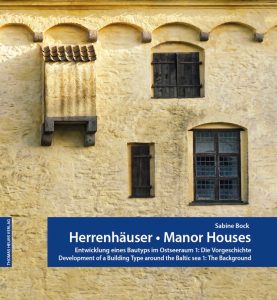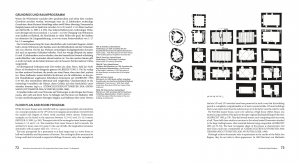First volume on the bilingual typology of manor houses in the Baltic Sea region is published
 Sabine Bock: “Herrenhäuser. Entwicklung eines Bautyps im Ostseeraum • Manor houses. Development of a Building Type around the Baltic sea: Teil 1 • Part 1: Die Vorgeschichte • The Background”
Sabine Bock: “Herrenhäuser. Entwicklung eines Bautyps im Ostseeraum • Manor houses. Development of a Building Type around the Baltic sea: Teil 1 • Part 1: Die Vorgeschichte • The Background”
Photographed by Thomas Helms, translated into English by Sabine Bock and Angelika Halama • Thomas Helms Verlag Schwerin www.thv.de | thv@thv.de
24,5 x 27,5 cm, 292 pages, hardcover, 346 illustrations, german/english, ISBN 978-3-944033-33-4
For nearly three decades the author have occupied herself with the manor houses in the Baltic Sea Region. Regardless of the actual use, regardless of whether they are in the kingdoms of Denmark, Norway or Sweden or in the republics of Germany, Finland, Russia, Estonia, Latvia, Lithuania or Poland, and regardless of which political camp they belonged to between 1918/1945 and 1990, they are all part of one historical cultural landscape. They are architectural testimonies to the manorial economy (Gutswirtschaft) that has dominated the Baltic Sea Region for centuries. In the context of the general history of the Baltic Sea Region and its agricultural system, the ideal-typical appearance of the manor houses is to be reconstructed in this typology in several time sections. Not individual houses are presented, but representative collages of different house details of all regions of the Baltic Sea Region and its hinterland.
All those who, for various reasons, whether as owner, resident, restorer, architect or visitor, with a manor house or are occupied generally interested in it, should be able to assign individual phenomena, components and forms, furnishings or room types to a stage of development. However, building occasions and individual connections between the builder and the chosen building form, dependencies on leading buildings and connections between the manor houses and simultaneous sacral and urban secular buildings are also to be shown. In the first volume presented now, the late medieval knights’ residences – tower houses/Wohntürme and halls/Saalbauten – are first presented as a kind of “prenatal” preliminary stage of the manor house.
CONTENTS
LATE MIDDLE AGES: THE LATE KNIGHTS’ RESIDENCES. Foreword | HISTORY. The Baltic Sea Region and its History. The Middle Ages. Trade and Christianisation. The Agricultural Condition in the Baltic Sea Region | INTRODUCTION. Time and Agriculture. From Landowner to Lord of the Domination and Leading Buildings. Subjects and their Dwellings. Nobility, Cities and Citizens. Nobility and Church. Location. Traditional Location. Location in the Settlement Association. Farmyards | KNIGHT’S RESIDENCE. Tower House and Hall. Urban Aristocratic Residences. Floor Plan and Room Program | STRUCTURAL AND INTERIOR WORK. Building Materials. Foundations. Exterior Walls. Masonry. Exposed Brickwork. Shaped Bricks, Plaster and Colours. Timber Construction. Roofs. Shapes Construction. Roofing. Defensive Components. Ceilings. Vaults. Wood-beam Ceilings. Stairs. Interior Walls. Doors. Windows. Building Inscriptions | ROOMS AND THEIR DECOR. Fixed Decor. Floors. Walls and Ceilings. Rooms and their Furnishings. Dirnitz. Dining Rooms. Stately Lounges. Sleeping Areas. Other Rooms | BUILDING SERVICES AND SUPPLY. Heaters. Heating Baskets/Braziers Hypocausts. Fireplaces. Tiled Stoves. Iron Stoves. Chimneys. Kitchens. Food Storage. Water Supply and Disposal. Latrines | TRADITION, PRESERVATION. Abandoned Settlements. Ruins and Romanticism. Integration. Tradition. Reconstruction | APPENDIX. Picture Credits Literature. Archives used. Index. Acknowledgments About the author, the photographer and the translator
For further information regarding the book contact Prof. Dr. Sabine Bock, Schwerin sabine.bock@thv.de

